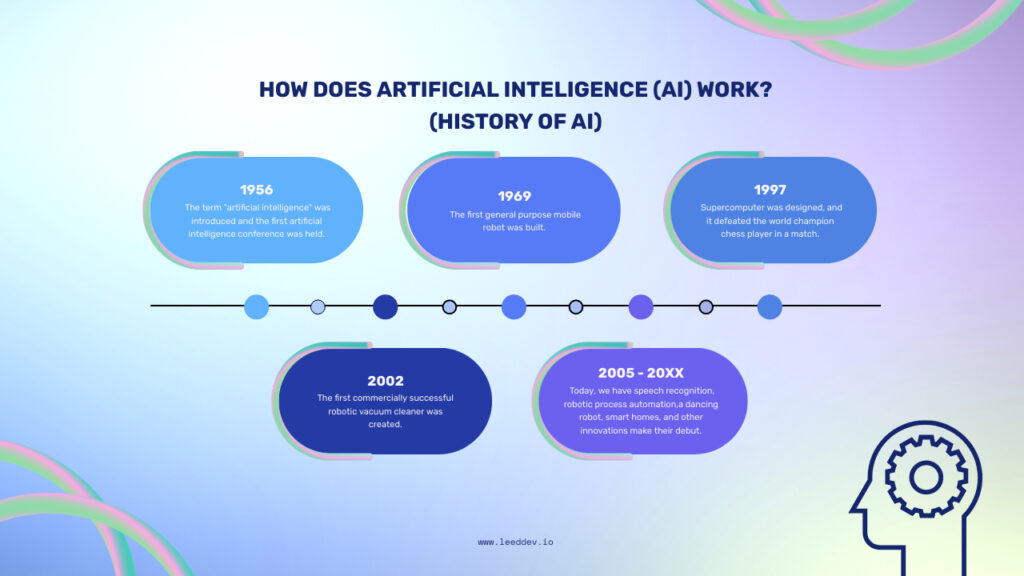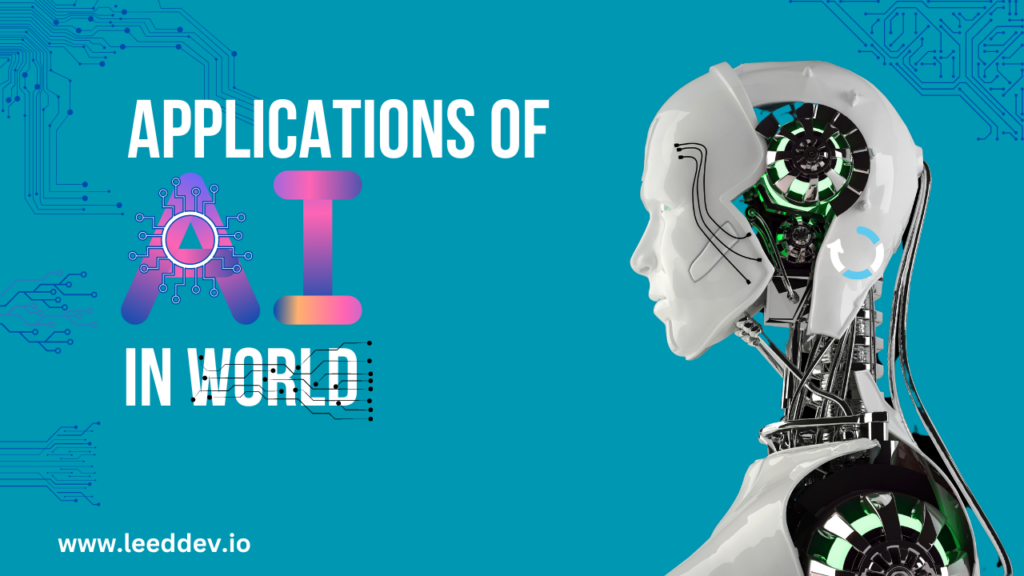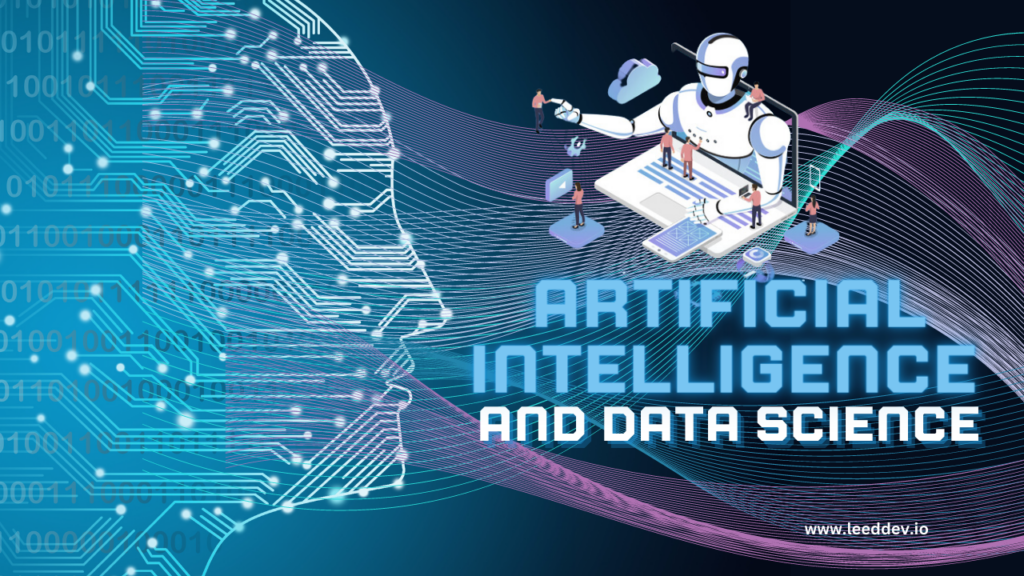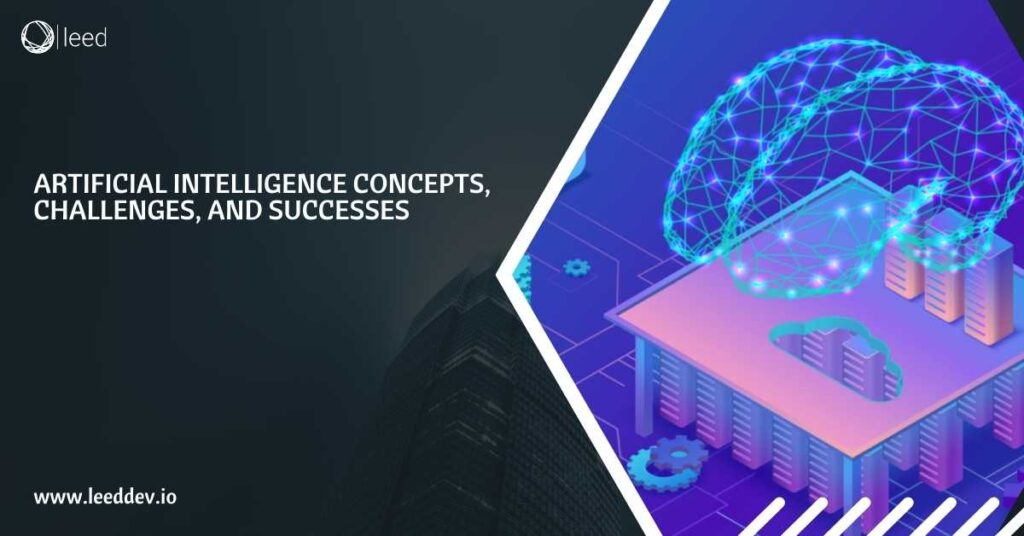Artificial Intelligence has become an integral part of our lives in today’s fast-paced technological age. Its capacity to simplify complex tasks and open the way for futuristic innovations. However, the exact definition and operation of AI, as well as its potential to replace human jobs, remain controversial topics.
To gain a better insight into this revolutionary technology, let us investigate how does ai work, assess its effects, and consider its ethical repercussions. Let us embark on this journey together as we unravel the mysteries surrounding Artificial Intelligence and discover how it’s shaping both present day and future lives!
Read also: MERN Stack Development Services with Modern Technologies
What is Artificial Intelligence (AI)?
Science fiction movies often associate AI technologies with a future where robots take over the world. However, in reality, humans train AI systems to perform specific tasks, making them simply computer machines. They learn from experience and use algorithms to perform human-like tasks. AI generated content is incredibly useful and can have a positive impact on businesses.
From self-driving cars to chess games, AI can perform a range of tasks from simple to complex problem solving. So, let go of the Hollywood stereotypes and embrace the true potential of AI technology.
The CEO of SAS software Jim Goodnight said that,
“AI has been an integral part of SAS software for years. Today we help customers in every industry capitalize on advancements in AI, and we’ll continue embedding AI technologies like machine learning and deep learning in solutions across the SAS portfolio”
History of Artificial Intelligence
Before discussing how does AI work, we need to know about the history of AI as well. Let’s have an overview on the history of AI.
- In the Early 1950s
In the 1950s, AI work was mostly related to simple tasks and problem solving skills. Resaercher used AI in 1956.
Marvin Minsky and Dean Edmonds were the ones who built SARC in 1951. This was one of the starting experiments in artificial intelligence. SARC stands for Stochastic Neural Analog Reinforcement Calculator. But now, there is a huge difference in the present technologies and the past
- 1n 1960s
This is the time where the US Department of Defense took interest in the field of ai research. This was started in the 1960s. They started to train computers and other machines to perform simple human tasks. In the 1970s, a street mapping project was completed by the Defense Advanced Research Projects Agency (DARPA).
- In 2003
DARPA was also the one who produced intelligent personal assistants in 2003. Since then many real time advancements have been made.
- The Present
In this era a lot of progress has been made in natural language processing nlp to changes in computer vision. Now AI machines are trained with pattern recognition and deep learning skills. It is predicted that further advancements will be done in AI that will help humans to solve tasks more efficiently.
How Does AI Work?
After understanding what artificial intelligence is and the history, the next thing we need to know is how does AI work. Artificial intelligence works by the combination of large amounts of data with different algorithms and methodologies. They can perform intelligent searches. Each time after running the data the machine checks its own performance and improves. AI machines can also predict and understand text and images and give better and relevant output.
What Disciplines Are Involved in AI?
There is a need to understand that AI is not just a single term, it’s a whole new discipline. It’s a combination of many technologies, theories and methodologies. The sub fields of AI are as follows:
- Machine Learning
Machine learning is a sub-discipline of artificial intelligence in which machines learn automatically based on experience. The term machine learning was used in 1959 by Arthur Samuel. The machine learning algorithms build a model which is known as training data. This helps develop better results, even when the machine isn’t trained to do so. The model is built on training data. The AI machines can understand images and text and then predict results. These are basically machines that learn from experiences.
- Neural Networks
Neural networks work in a way like the human brain does. They are made of different interconnected units that are responsible for the transfer and processing of information. The interconnected units are known as nodes or neurons as in the human brain. The neural networks are implemented based on different parameters and mathematical operations. They work by recognizing the hidden patterns, experience, and correlating them to generate efficient output. It is a type of Machine learning which finds association between the data and gives results in a meaningful way.
- Deep Learning
It is also a sub field of artificial intelligence that is similar to neural networks. Also works in the form of neurons working in the human brain. Its quite similar to a neural network but the main difference is the nodes and depth of layers. If a neural network consists of more than three layers it is considered as a Deep learning neural network. This helps the AI machines answer difficult questions and solve problems. Deep Learning are basically self educating machines.
Will Artificial Intelligence Replace Humans?
You must have an idea of how does AI work. So what do you say will AI replace humans? Although, Artificial Intelligence has made our lives easy. Most of the tasks are now performed by machines.
Now we have multiple machines to perform these daily tasks. Like taking an example of a simple calculator. It’s easy to perform mathematical calculations rather than calculate them manually. It’s just a simple example.
But the point is that all these algorithms and machines are made by Humans. No machine can advance the human brain. No doubt, there will be further advancements in AI. But Artificial Intelligence can’t take the place of humans.
Pros and Cons of Artificial Intelligence
Pros
Some of the Advantages of artificial intelligence are:
- Reduced chances of error
- Efficiency
- Accuracy
- Availability at any time
- Can perform human based task in a better manner
- Personalization
- Consistency
- Can predict better outcomes
- Time saving
- Can perform repetitive tasks
- New inventions are made
Cons
Some of the Disadvantages of artificial intelligence are:
- Expensive Process
- Unemployment
- Less Creativity
- Makes Human Lazy
- Security Issues
- Lack of Emotional Intelligence
- Too Much Dependency on Artificial Intelligence
- Less Improvement
Interesting Facts About AI
Let’s discuss some interesting information about Artificial Intelligence:
- In 1943, The Evolution of Artificial Neurons was proposed by Warren McCulloch and Walter Pitts in 1943. The model was a combination of artificial neuron networks and evolutionary search algorithms.
- The First Chatbot ELIZA was made from 1964 to 1966. It was created by Joseph Weizenbaum. Eliza was the first chatbot that was able to mimic human conversation
- In 1936, Invention of the Turing Machine took place. The machine was designed to compute real numbers
- The word Artificial Intelligence was coined in 1956
- In 1973, First Intelligent Robot WABOT 1 was created. The robot was able to communicate with humans in the Japanese language and was able to grab and hold things. It was developed by Ichiro Kato at Tokyo’s Waseda University.
- “Deep Blue” was the first computer to beat a World chess champion in 1997. The commentator said about the champion Garry Kasparov, “He can’t believe it”.
- In 1996 Al entered our household. The first Vacuum cleaner was Electrolux Trilobite. Although it had some issues, it was the start of a new era.
- On July 9 2012, Google launched ‘Google Now’. Galaxy Nexus smartphone was the first to support it
Examples of Artificial Intelligence
Now you know how does AI work and the relevant information regarding it. Now the next thing is to discuss the examples of Artificial Intelligence. Some of the common and popular examples are:
- ChatGPT
ChatGPT is the most popular AI tool nowadays. It was launched in November 2022. It can write any content asked and is a best tool for the students. Even remove plagiarism and can answer simple to complex questions
- Snapchat
Snapchat is another app that recognizes facial movements. You can also apply filters as well. It uses an ML algorithm which distinguishes the images background and face.
- Google Maps
Google Map is another service that has made life easy for us. Now it is easy to get the route of the location where we want to go. Google Map uses Artificial intelligence services to give better location services and give the user a smooth experience.
Conclusion
To summarize the discussion, now you know how does AI work, the history, pros and cons and the relevant examples. Artificial intelligence has made the life of humans easy. Because of artificial intelligence a drastic change has come since the past. AI is a rapidly advancing field and undoubtedly there will be more advancements in this field. Application of AI has helped mankind in every field ranging from household items to medical issues. Although things have changed due to AI, there is no way that AI can take the place of humans. It does affect unemployment of humans to some extent. But how could a thing that is made by humans take their place? This is a question that is debatable.
Frequently Asked Questions (FAQs)
Q No.1 Is there an AI app that is free?
Answer: MS Bing while initially available to few is now available to everyone to use for free. It is a mixture of a search engine combined with a chatbot that can look up queries and complex questions.
Q No.2 What are the best AI apps right now?
Answer: Some of the best AI apps right now are as follows:
- Microsoft Bing.
- Google Assistant
- Genie AI Chatbot
- Siri
- Youper – CBT Therapy.
- Microsoft Cortona
- Luma AI
- Alexa
- Seeing AI.
- FaceApp.
- Otter AI.
- Be My Eyes.
Q No.3 Is AI harmful or not?
Answer: The impact of AI can be both beneficial and potentially harmful, depending on how it is developed, deployed, & regulated. However, addiction to AI can cause problems so it is crucial to approach AI with a balanced perspective.
Q No.4 Is AI Smarter Than humans?
Answer: AI systems might already be outsmarting us. The AI knows hundreds of times more than a single human can. However, it still lacks the broad intelligence that humans possess.
Q No.5 What is the biggest danger of AI?
Answer: The biggest danger associated with AI lies in its potential misuse or unintended consequences.
Q No.6 What is the best AI camera?
Answer: Some of the best Artificial Intelligence cameras are as follows:
- Focos.
- Prisma.
- Lensa.
- Adobe Photoshop Camera.
- Filmic Pro V7
Q No.7 Why is AI famous now?
Answer: AI is famous now due to advancements in technology, practical applications, improved performance, business impact, media coverage, economic potential, and cultural influence.
Q No.8 What type of AI is Siri?
Answer: Siri falls under the category of Natural Language Processing and Voice Recognition. Siri is developed by Apple and is designed to interact with users through voice commands and respond to queries and provide information on Apple devices.
Q No.9 What is the future of AI?
Answer: The future of AI holds promise for increased automation, personalized experiences, ethical considerations, collaboration between humans and AI, and new apps in various industries.
Q No.10 Which AI is trending?
Answer: The top trending AI of today are:
- DALL-E
- Google Images
- OpenAI
- Apple Siri
- Facebook AI Research (FAIR)
- Conversational AI
- AI-Based Cybersecurity
- Baidu Research
- Computer Vision Technology in Businesses
- Alibaba Cloud AI
- Microsoft Azure Cognitive Services
- AI for Content Generation.




